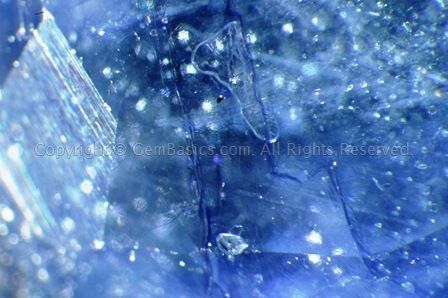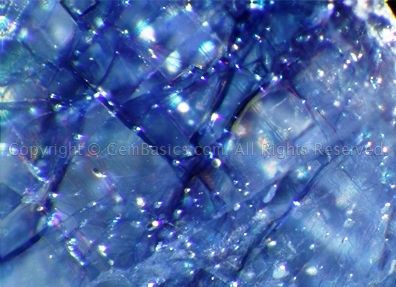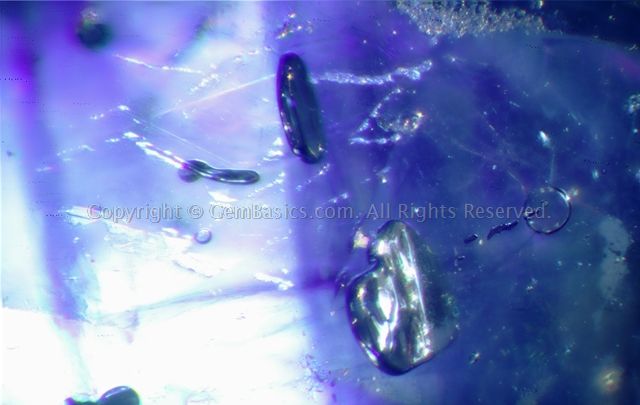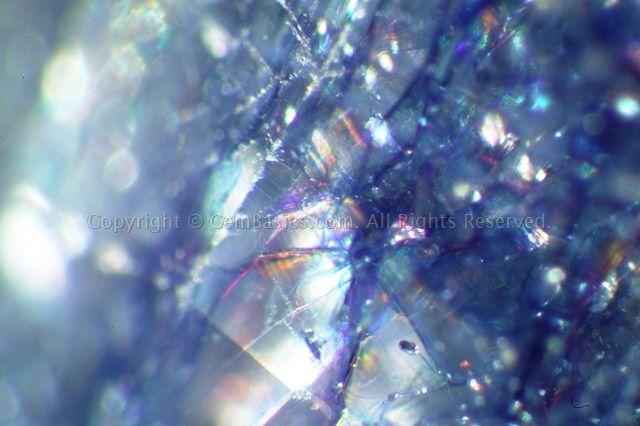www.GemstoneBasics.com
Photomicrography > Corundum > Cobalt glass-filled sapphires
First draft: May 15th, 2014 | Last update: March 18th, 2016
Diagnostic Features of Glass-Filled Sapphires
Cobalt (Co) Glass
Although originally (in 2007) named Super Diffusion Tanusorn, these sapphires are not diffused at all. Instead, their fractures were filled with cobalt (Co) glass. As blue sapphires are coloured by ferrous iron (Fe2+) - which quenches fluorescence - no reaction is expected under a Chelsea filter. But the filler does react.
This reaction should be carefully observed, because some blue sapphires - especially some from Myanmar and Sri Lanka - also tend to contain some chromium (Cr) which causes a uniform colour reaction under the Chelsea filter. But in case of the Supers, it is actually only the filler that causes a reaction.
References and items of related interest
Anonymous (2007). New blue treated sapphire. Gem & Jewelry Institute of Thailand Online Report on Gem & Jewelry Institute of Thailand
Anonymous (2012). Corundum: with glass filled fissures, with glass filled cavities, with/and glass (manufactured product). Laboratory Manual Harmonization Committee Information Sheet, No. 3, Version 9, last updated December 2012 on www.lmhc-gemology.org
Ahmadjan, A. (2007). Treatment in Blue Sapphire "Super Diffusion Tanusorn" - filling treatment with cobalt-coloured lead glass. GAAJ-Zenhokyo Online Report, published on Gemmological Association of All Japan
de Vincenti, C. (2012). Rubis et saphirs sont de plus en plus traites (1e partie). Gold'Or, No. 6, pp. 62-63 (in French).
de Vincenti, C. (2012). Rubis et saphirs sont de plus en plus traites (2e partie). Gold'Or, No. 7, pp. 68-69 (in French).
Emmett, J.L. (1999). Fluxes and the Heat Treatment of Ruby and Sapphire. Gems & Gemology, Vol. 35, No. 3 (Fall), pp. 90-92.
Hainschwang, T. (2008). Lead-glass-treated blue sapphire. Gems & Jewellery, Vol. 17, No. 3, pp. 3-5. preview
Leelawatanasuk, T. (2012). Urgent Lab Info: “Blue dyed and clarity modified sapphire with cobalt + lead-glass filler in fractures and cavities”. Gem & Jewelry Institute of Thailand Online Report, published on Gem & Jewelry Institute of Thailand
Leelawatanasuk, T., Atitchat, W., Pisutha-Arnond, V., Wattanakul, P., Papawarin Ounorn, P., Manorotkul, W. & Hughes, R.W. (2013). Cobalt-Doped Glass-Filled Sapphires: An Update. Australian Gemmologist, Vol. 25, No. 1, pp. 14–20, and on www.ruby-sapphire.com
Leelawatanasuk, T. & Maneekrajangsaeng, M. (2013). Urgent Lab Info: "Reconstructed sapphire: a new type of manmade gem corundum". Gem & Jewelry Institute of Thailand Online Report, published on Gem & Jewelry Institute of Thailand
Nassau, K. (1981). Heat Treating Ruby and Sapphire: Technical Aspects. Gems & Gemology, Vol. 17, No. 3 (Fall), pp. 121-131.
Nassau, K. (1984). The Early History of Gemstone Treatments. Gems & Gemology, Vol. 20, No. 1 (Spring), pp. 22-33.
Okano, M. & Kitawaki, H. (2010). Sapphire in various colours filled with lead-glass. Gemmology, Japan, Vol. 41, No. 488-489, pp. 2-3.
Scarratt, K. & Harding, R.R., Din, V. K. (1986). Glass Filling in Sapphire. The Journal of Gemmology, Vol. 20, No. 4, pp. 203-207.
Smith, C.P. (2013). Cobalt-Colored Composite Sapphires Now Entering the Market. American Gemological Laboratories Press Release on www.aglgemlab.com
Themelis, T. (1992). The Heat Treatment of Ruby and Sapphire. 1st Ed., Gem Lab Inc., Clearwater, Florida, 236 p. ISBN 0-940965-10-0.
Themelis, T. (2004). Flux-Enhanced Rubies & Sapphires. Private publication, Bangkok, 48 p. ISBN 0-940965-42-9.
Themelis, T. (2013). Cobalt-Infused Lead-Glass-Filled Sapphires on www.themelis.com
Photomicrographs

Surface-reaching crevices are not as diagnostic as colour-saturated cracks
18x (FoV ± 3mm) Obl, DF, X-Pol

Both flat as round gas bubbles are present, although coloured fissures predominate
25x (FoV ± 2.5mm) Obl, DF, X-Pol

This and the next one are clear cases of deeply coloured fissures and gas bubbles ...
Obl, DF, X-Pol | L 30x (FoV ± 2.5mm) | R 50x (FoV ± 1.5mm)


As diagnostic as colour-saturated cracks are these colour flashes
Obl, DF, X-Pol | L 30x (FoV ± 2.5mm) | R 40x (FoV ± 2mm)

